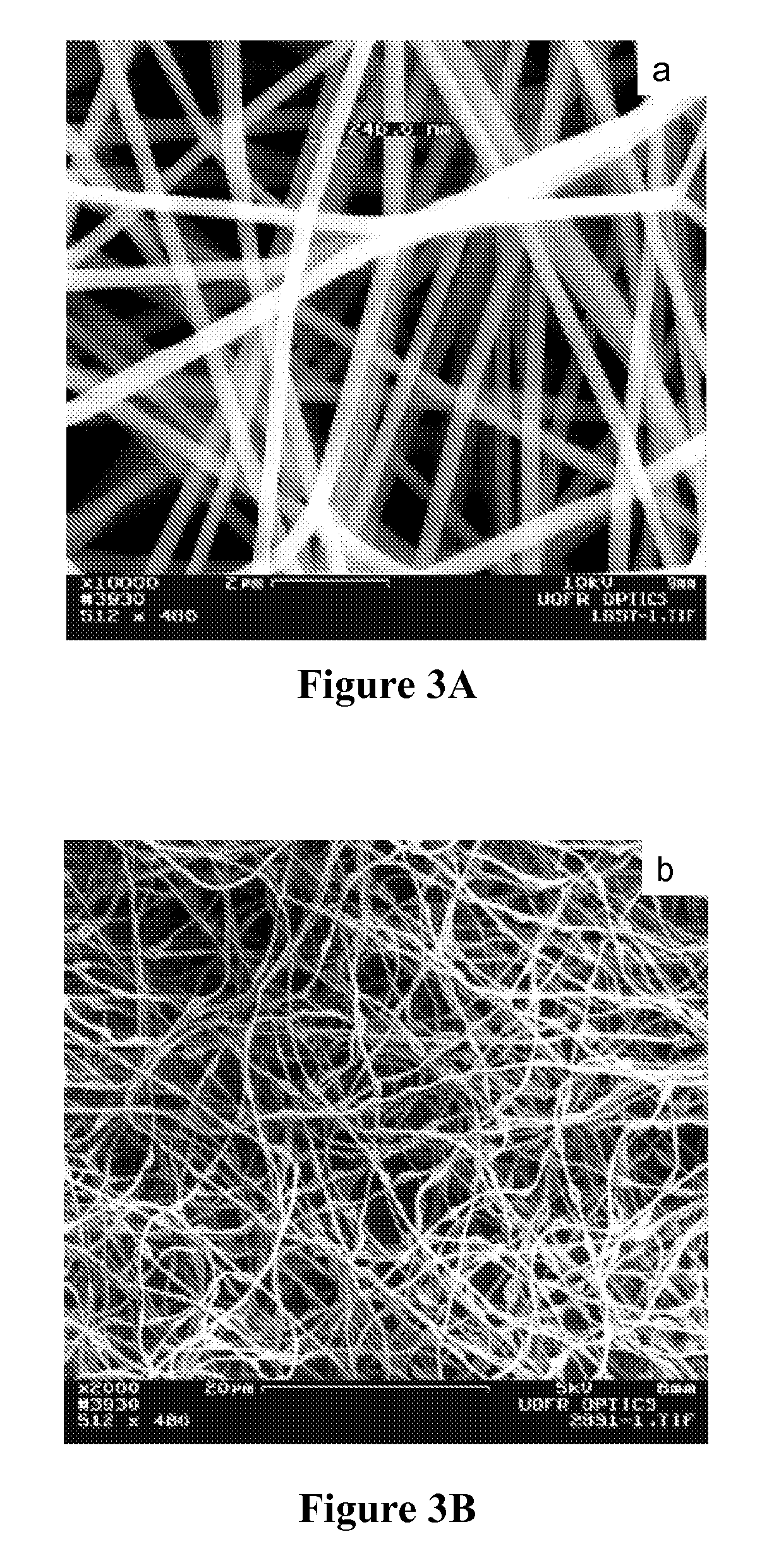Long metallic nanowires, methods of making, and use thereof in proton exchange membrane fuel cell
- Summary
- Abstract
- Description
- Claims
- Application Information
AI Technical Summary
Benefits of technology
Problems solved by technology
Method used
Image
Examples
example 1
Electrospinning Setup
[0070]The setup for electrospinning has been described previously (Li et al., Adv. Mater. 16:1151-1170 (2004), which is hereby incorporated by reference in its entirety), and is illustrated schematically in FIG. 1. The set up includes a high voltage supplier (Dongwen, Tienjing, China), a syringe pump (Harvad Pump 11, USA), and a plastic syringe equipped with a 22 gauge needle made of stainless steel. Carbon paper was used to collect the fibers. The carbon paper and needle were coupled to the high voltage supplier as shown.
[0071]The syringe pump was filled with a solution including a polymer precursor material and one or more metal salts, and upon injection of the solution across the DC electric field, composite nanofibers were formed. The parameters for formation of specific composite fibers and their use to form substantially pure metal or alloy nanofibers are described in the subsequent examples.
example 2
Fabrication of Long Nanowires of Metallic Platinum by Electrospinning
[0072]In the instant experiment, high molecular weight poly(vinyl pyrrolidone) (PVP) (molecular weight: 1300000) and chloroplatinic acid hydrate (H2PtCl6) with H2O and C2H5OH were selected to make the precursor solution. Through electrostatic spinning, H2PtCl6, / PVP composite nanofibers were obtained. Heating the composite nanofibers at high temperatures removed PVP, H+, and Cl−, where the metallic platinum long fibers were left behind. The fiber diameter and length can be tailored by adjusting the composition of the precursor solution and the spinning parameters, with higher concentrations yielding thicker diameter fibers and lower concentrations yielding thinner diameter fibers. The precursor solution composition and spinning parameters used in the instant experiment are listed in Table 1 below.
TABLE 1Range of Precursor Solution Compositionand Other Spinning ParametersPVP concentration (mg / ml)10~50H2PtCl6•6H2O (mg...
example 3
Fabrication of Long Nanowires of Metallic Platinum / Nickel Alloy by Electrospinning Technique
[0080]The solution for PtNi3 alloy nanofibers included H2PtCl6 (˜15 mg / ml), NiCl2 (˜14.5 mg / ml), and polyvinylpyrrolidone (PVP) (˜16 mg / ml) dissolved in ethanol / water (81:19 volume ratio). After electrostatic spinning using a pump rate of 0.3 ml / hr and electric field of 7 kv / 5 cm, composite fibers were obtained. Heating the composite nanofibers at 340° C. / air / 10 min, then at 500° C. / (H2 / Ar) / 30 min produced the PtNi3 alloy nanofibers. The obtained alloy nanowire was confirmed by the X-ray diffraction pattern shown in FIG. 4. FIGS. 9A-B are SEM and TEM images of PtNi3 alloy nanofiber.
PUM
| Property | Measurement | Unit |
|---|---|---|
| Temperature | aaaaa | aaaaa |
| Temperature | aaaaa | aaaaa |
| Length | aaaaa | aaaaa |
Abstract
Description
Claims
Application Information
 Login to View More
Login to View More - R&D
- Intellectual Property
- Life Sciences
- Materials
- Tech Scout
- Unparalleled Data Quality
- Higher Quality Content
- 60% Fewer Hallucinations
Browse by: Latest US Patents, China's latest patents, Technical Efficacy Thesaurus, Application Domain, Technology Topic, Popular Technical Reports.
© 2025 PatSnap. All rights reserved.Legal|Privacy policy|Modern Slavery Act Transparency Statement|Sitemap|About US| Contact US: help@patsnap.com



